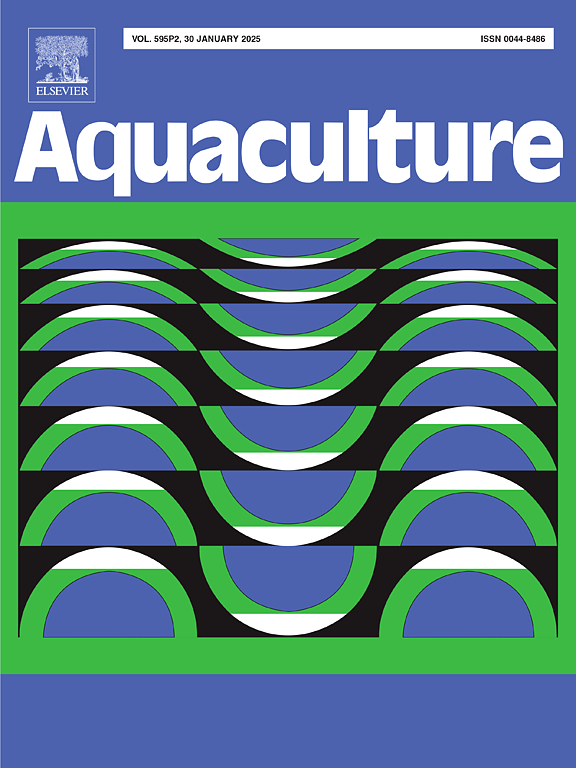Effects of β-hydroxy-β-methylbutyrate inclusion on growth performance and fillet quality of olive flounder Paralichthys olivaceus fed low fishmeal based diets
IF 3.9
1区 农林科学
Q1 FISHERIES
引用次数: 0
Abstract
β-Hydroxy-β-methylbutyrate (HMB) has been shown to improve animal growth and muscle quality. An 8-week feeding trial was thus performed to investigate whether HMB supplementation could improve the growth and fillet quality in olive flounder Paralichthys olivaceus fed low fishmeal based diets. Fish (body weight: 1.29 ± 0.00 g) were fed a fishmeal-based diet (named FM diet containing 60 % fishmeal), a low fishmeal based diet (named SM diet, 36 % fishmeal was replaced by soybean meal based on the FM diet) and the SM diet supplemented with 0.05 %, 0.1 %, 0.2 % and 0.4 % β-hydroxy-β-methylbutyrate calcium (named SMH0.05, SMH0.1, SMH0.2 and SMH0.4 diets respectively). Results showed that weight gain rate (WGR) and specific growth rate (SGR) of fish fed FM were significantly higher than those of the SM and HMB-supplemented groups. These parameters in the SMH0.1, SMH0.2 and SMH0.4 groups were significantly enhanced than in fish fed SM with the highest values observed in the SMH0.2 group. Fish fed SMH0.2 and FM shared similar feed efficiency ratio (FER) and protein efficiency ratio (PER) which were significantly higher than those of the SM and SMH0.05 groups. Meanwhile, fish fed SM displayed significantly lower fillet hardness, springiness and chewiness, while higher muscle liquid loss and water loss than those of the FM group. Inclusion of 0.2 % and 0.4 % HMB significantly increased above texture parameters of fish fed SM, though these values still did not reach to levels achieved in the FM group. But muscle liquid loss and water loss were both reduced to levels similar as those in fish fed FM by supplementing 0.2 % and 0.4 % HMB. Myofiber density and sarcomere length of fillet in the SMH0.2 group were significantly elevated than in fish fed SM, although these values were still significantly lower than in the FM group. Moreover, fish fed SM exhibited significantly lower expression of myogenic regulatory factors (myf5, myod and mrf4) and protein synthesis-related factors (igf1, pi3k, akt, tor, s6, P-TOR and P![]() S6), while higher transcriptions of protein degradation-related genes (foxo1, murf-1 and mafbx) in muscle than those of the FM group. However, HMB inclusion in SM diet restored the expression of above genes and proteins to some extent with the maxima or minima found in the SMH0.2 group. In conclusion, dietary HMB improved growth and fillet texture of olive flounder fed low fishmeal based diets. The appropriate HMB level in SM diet for olive flounder was estimated to be 0.2 % based on the growth and feed performance parameters (WGR, SGR, FER and PER).
S6), while higher transcriptions of protein degradation-related genes (foxo1, murf-1 and mafbx) in muscle than those of the FM group. However, HMB inclusion in SM diet restored the expression of above genes and proteins to some extent with the maxima or minima found in the SMH0.2 group. In conclusion, dietary HMB improved growth and fillet texture of olive flounder fed low fishmeal based diets. The appropriate HMB level in SM diet for olive flounder was estimated to be 0.2 % based on the growth and feed performance parameters (WGR, SGR, FER and PER).
低鱼粉饲料中添加β-羟基-β-甲基丁酸盐对橄榄比目鱼生长性能和鱼片品质的影响
β-羟基-β-甲基丁酸酯(HMB)已被证明能改善动物生长和肌肉品质。本试验旨在研究在低鱼粉饲料中添加HMB是否能改善橄榄比目鱼生长和鱼片质量。分别饲喂体重为1.29±0.00 g的鱼粉基础饲粮(鱼粉含量为60%)、低鱼粉基础饲粮(SM饲粮,在FM饲粮的基础上以豆粕替代36%的鱼粉)和SM饲粮中分别添加0.05%、0.1%、0.2%和0.4% β-羟基-β-甲基丁酸钙(分别命名为SMH0.05、SMH0.1、SMH0.2和SMH0.4饲粮)。结果表明:鱼粉组的增重率(WGR)和特定生长率(SGR)显著高于添加SM和hmb组。这些参数在SMH0.1、SMH0.2和SMH0.4组均显著高于SM,其中以SMH0.2组最高。饲料效率(FER)和蛋白质效率(PER)相近,均显著高于SM和SMH0.05组。同时,鱼片硬度、弹性和咀嚼力显著低于鱼粉组,肌肉失水和失水显著高于鱼粉组。添加0.2%和0.4%的HMB显著提高了SM组的上述织构参数,但仍未达到FM组的水平。但肌肉的液体损失和水分损失都减少到与添加0.2%和0.4% HMB的鱼类相似的水平。SMH0.2组的肌纤维密度和鱼片肌节长度均显著高于饲料SM组,但仍显著低于饲料FM组。此外,SM组肌肉中肌生成调节因子(myf5、myod和mrf4)和蛋白质合成相关因子(igf1、pi3k、akt、tor、s6、P-TOR和PS6)的表达量显著低于FM组,而蛋白质降解相关基因(foxo1、murf-1和mafbx)的转录量显著高于FM组。然而,SM日粮中加入HMB在一定程度上恢复了上述基因和蛋白质的表达,并以SMH0.2组为最大值或最小值。综上所述,低鱼粉饲粮中添加HMB促进了橄榄比目鱼的生长和鱼片质地。根据生长性能和饲料性能参数(增重率、SGR、FER和PER)估算,SM饲粮中适宜的HMB水平为0.2%。
本文章由计算机程序翻译,如有差异,请以英文原文为准。
求助全文
约1分钟内获得全文
求助全文
来源期刊

Aquaculture
农林科学-海洋与淡水生物学
CiteScore
8.60
自引率
17.80%
发文量
1246
审稿时长
56 days
期刊介绍:
Aquaculture is an international journal for the exploration, improvement and management of all freshwater and marine food resources. It publishes novel and innovative research of world-wide interest on farming of aquatic organisms, which includes finfish, mollusks, crustaceans and aquatic plants for human consumption. Research on ornamentals is not a focus of the Journal. Aquaculture only publishes papers with a clear relevance to improving aquaculture practices or a potential application.
 求助内容:
求助内容: 应助结果提醒方式:
应助结果提醒方式:


